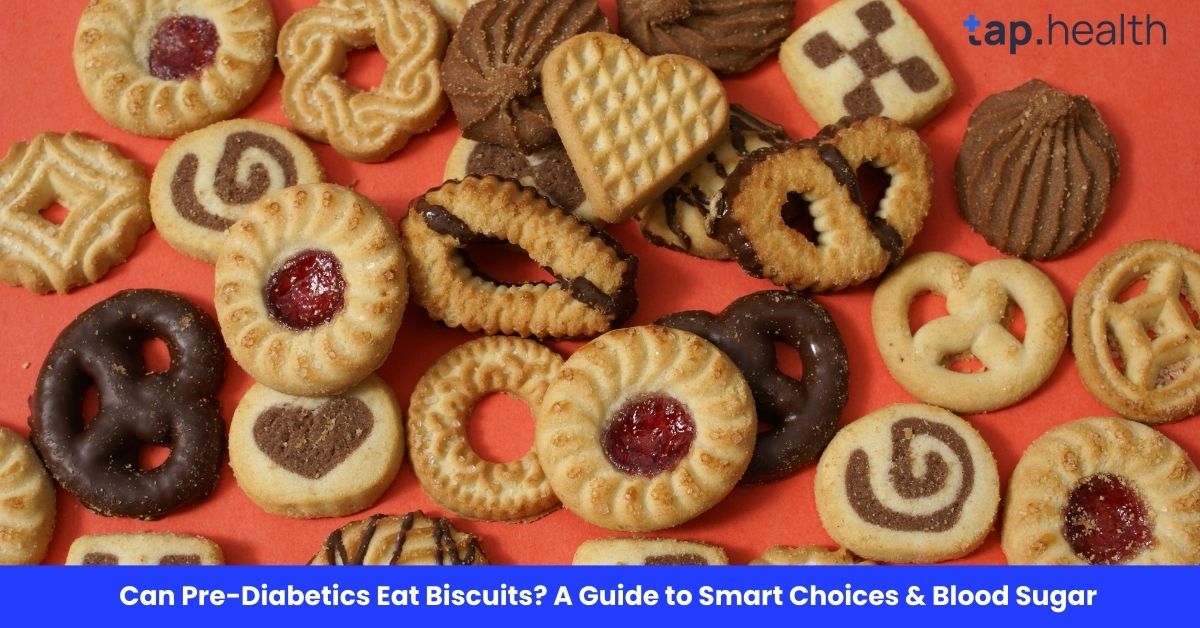So, you’ve been told you have pre-diabetes. It’s a term that can feel confusing and a little scary. Suddenly, you’re thinking about every single thing you put in your mouth. And one big question pops up: what about my favorite snacks? Can pre-diabetics eat biscuits?
The answer isn’t a simple yes or no. It’s more like: “Yes, but you have to be incredibly smart about it.”
Pre-diabetes is your body’s warning sign. It means your blood sugar levels are higher than normal, but not high enough yet to be type 2 diabetes. The great news is that it’s a chance to make changes. You can often reverse pre-diabetes with a healthier diet and lifestyle.
This doesn’t mean you must never enjoy a biscuit again. It means you need to become a biscuit detective. You need to understand what’s in them, how they affect your body, and how to fit them into your new eating plan without undoing your progress.
This guide will walk you through everything you need to know. We’ll break down the science into simple terms, look at the best and worst biscuit choices, and give you practical tips to satisfy your craving without spiking your blood sugar.
What Does Pre-Diabetes Really Mean? Understanding Your Body
First, let’s get on the same page about what pre-diabetes is. Think of it like this:
Your body’s main source of energy is a sugar called glucose. When you eat food, especially carbohydrates (like biscuits, bread, or pasta), your body breaks it down into glucose. This glucose enters your bloodstream.
Once it’s in your blood, a hormone called insulin acts like a key. It unlocks your cells’ doors to let the glucose in, so it can be used for energy.
If you have pre-diabetes, this system starts to get a little rusty. One of two things happens:
- Your pancreas doesn’t make enough insulin.
- Or, your cells stop responding well to insulin. This is called insulin resistance.
Because of this, the glucose has trouble getting into your cells. It has nowhere to go, so it just hangs out in your bloodstream. This leads to high blood sugar levels.
The goal with pre-diabetes is to avoid overwhelming this already struggling system. You want to eat foods that release glucose slowly and steadily, not all at once in a big rush. This gives your insulin time to do its job properly.
The Biscuit Problem: Why Most Are Trouble for Blood Sugar
Now, let’s look at the typical biscuit. What’s in it? If you pick up a packet of popular cream-filled, chocolate-coated, or even plain digestive biscuits, the ingredient list usually reads like this:
- Refined Wheat Flour: This is flour that has had the bran and germ stripped out. This process also removes most of the fiber, which is crucial for slowing down digestion.
- Sugar: Often the second or third ingredient. This is pure, fast-acting carbohydrate.
- Vegetable Oils (Palm, Sunflower): These add fat, which can sometimes be unhealthy saturated fats.
- High-Fructose Corn Syrup or Glucose Syrup: More added sugars with different names.
When you eat a biscuit made with these ingredients, here’s what happens inside your body:
- Rapid Breakdown: Your body quickly digests these refined carbs and sugars because there’s no fiber to slow it down.
- Sugar Flood: A large amount of glucose rushes into your bloodstream all at once.
- Panic Mode: Your pancreas (which is already struggling) gets a panic signal to pump out a large amount of insulin to deal with the sugar surge.
- The Struggle: Because of insulin resistance, your cells don’t respond well. The insulin has to work extra hard to force the glucose into the cells.
- The Spike and Crash: Your blood sugar levels spike very high. You might get a short energy burst, but soon after, you’ll likely crash, feeling tired, shaky, and hungry again.
Doing this repeatedly puts immense stress on your pancreas and makes insulin resistance worse, pushing you closer to a full type 2 diabetes diagnosis.
Becoming a Biscuit Detective: How to Read a Label
The most important skill you can learn is how to read a nutrition label. Don’t just look at the pretty picture on the front of the packet. Turn it over and look at the facts.
Here’s what to zero in on:
1. Serving Size
This is the first thing you must check. Companies often list the nutrition facts for a serving size that is much smaller than what people actually eat. For example, a serving might be “one biscuit.” But who eats just one?
2. Total Carbohydrates
This number includes all forms of carbs: starches, sugar, and fiber. For a pre-diabetic, this is a key number to watch. A good rule of thumb for a snack is to aim for 15-20 grams of total carbohydrates or less.
3. of which Sugars
This tells you how many grams of those total carbs are pure sugar. The lower, the better. Look for biscuits with less than 5-6 grams of sugar per serving.
4. Fiber
Fiber is your best friend. It slows down digestion, prevents blood sugar spikes, and keeps you feeling full. Look for biscuits that have at least 2-3 grams of fiber per serving. The more, the better!
5. Ingredients List
Ingredients are listed in order of weight. The first ingredient is what the product contains the most of.
- Red Flag: If “sugar,” “refined wheat flour,” or “high-fructose corn syrup” is one of the first three ingredients, put it back.
- Green Flag: Look for “whole grain [flour],” “oats,” “almond flour,” or “coconut flour” as the first ingredient.
How Biscuits Impact Blood Sugar Levels
One of the main concerns for pre-diabetics when it comes to food is how it affects their blood sugar. Let’s explore how biscuits, which are often considered a sweet snack, impact blood sugar levels.
1. Carbohydrates in Biscuits
Most biscuits are high in carbohydrates, which are broken down into glucose in the body. When you eat a biscuit, your body converts the carbs into glucose, causing a rise in blood sugar levels. For pre-diabetics, this spike in blood sugar can be problematic because their body is already struggling to regulate blood glucose effectively.
- Refined Carbs: Many biscuits are made with refined flour, which is processed and lacks fiber. This means they cause a quick spike in blood sugar.
- Sugar Content: Biscuits often contain added sugars, which further increase the glycemic load and lead to rapid spikes in blood sugar.
2. Glycemic Index of Biscuits
The glycemic index (GI) is a measure of how quickly a carbohydrate-containing food raises blood sugar levels. Foods with a high GI can cause rapid blood sugar spikes, while those with a low GI release glucose more gradually into the bloodstream. Most commercially produced biscuits tend to have a high GI due to the refined ingredients and sugar content.
This means that when pre-diabetics consume biscuits, especially in large quantities, they can experience significant spikes in blood sugar, which makes managing pre-diabetes more difficult.
3. Portion Sizes Matter
Even though biscuits can affect blood sugar levels, portion size plays an important role. Eating one or two biscuits may have a lesser impact than eating an entire packet. However, it’s important to remember that consuming biscuits, even in small amounts, could still affect your blood sugar depending on the type of biscuit and the ingredients used.
Can Pre-Diabetics Eat Biscuits?
The short answer is yes, but in moderation. Pre-diabetics can still enjoy biscuits occasionally, but they must be mindful of portion sizes and the ingredients. It’s crucial to select the right kind of biscuits and eat them as part of a balanced diet that controls blood sugar levels.
Factors to Consider Before Eating Biscuits as a Pre-Diabetic:
- Ingredients: Look for biscuits with whole grains, minimal added sugars, and healthy fats. Biscuits made with refined white flour, sugar, and trans fats should be avoided.
- Glycemic Index: Choose biscuits that have a lower glycemic index. Biscuits made with whole wheat flour, oats, or nuts are typically better choices.
- Portion Control: Keep the serving size small. Limit the number of biscuits you consume and consider pairing them with protein or healthy fats to help stabilize blood sugar.
- Sugar Alternatives: If you opt for sugar-free biscuits, be aware that they often contain sugar alcohols or artificial sweeteners, which can still have an effect on your blood sugar levels.
The Best and Worst Biscuit Choices for Pre-Diabetes
Not all biscuits are created equal. Some are far worse than others. Here’s a breakdown to help you navigate the supermarket aisle.
Biscuits to Avoid or Seriously Limit
These are the biggest culprits for blood sugar spikes:
- Cream-Filled Biscuits: These are a double whammy of refined flour and sugary filling.
- Chocolate-Coated Biscuits: They add a significant layer of sugar and fat.
- Shortbread and Butter Biscuits: Very high in refined flour and often saturated fat.
- Traditional Digestives: While they seem plain, they are still made primarily with refined flour and a fair amount of sugar.
- Biscuits with Frosting or Icing: Pure sugar on top of more sugar.
Better Biscuit Choices (In Moderation!)
These options are better because they often contain more fiber or whole grains:
- Whole Oat Biscuits/Crackers: Oats are a great source of soluble fiber.
- Biscuits made with Nut Flours: Almond flour or coconut flour biscuits are lower in carbs and higher in protein and healthy fats.
- High-Fiber Crispbreads: Like rye crispbread or whole grain crackers. They are often low in sugar and high in fiber.
- Homemade Biscuits: Where you control the ingredients (see section below).
How to Enjoy a Biscuit Safely: The Rules of the Game
If you decide you really want a biscuit, follow these rules to minimize the impact on your blood sugar.
1. The Portion Control Rule
This is the #1 most important rule. Do not eat from the packet. Take one biscuit, put it on a plate, and put the packet away. One biscuit is almost always enough to satisfy the craving without causing a major spike.
2. The Pairing Rule
Never eat a carbohydrate by itself. Always pair your biscuit with a source of protein or healthy fat. This powerful combo slows down the digestion of the carbs, leading to a slower, gentler rise in blood sugar.
- Have one biscuit with a handful of almonds.
- Eat it with a small slice of cheese.
- Enjoy it with a spoonful of peanut butter.
- Have it after a meal that contained protein and vegetables, not on an empty stomach.
3. The Timing Rule
The best time to have a treat is after a balanced meal. If you’ve just eaten a lunch of grilled chicken and a large salad, your body is already digesting food slowly. Adding one biscuit to the end of this meal will have a much smaller effect than if you ate it by itself as a mid-morning snack.
4. The Mindful Eating Rule
Sit down. Slow down. Actually taste the biscuit. Enjoy every single bite. When you eat mindfully, you are more satisfied with less. This is the opposite of mindlessly munching through a whole packet while watching TV.
Fantastic & Healthy Alternatives to Traditional Biscuits
Sometimes, the craving is for something crunchy and sweet, not necessarily a specific biscuit. Here are some fantastic alternatives that will truly support your health goals.
1. The Ultimate Swap: DIY Healthy Biscuits
Baking your own puts you in the driver’s seat. You can:
- Use whole wheat flour, oat flour, or almond flour instead of refined white flour.
- Cut the sugar in any recipe by 1/3 to 1/2. You often won’t notice the difference.
- Use natural sugar substitutes like mashed banana, unsweetened applesauce, or a small amount of dates.
- Add healthy fats and protein with nuts, seeds, or nut butter.
- Recipe Idea: Search for “3-ingredient banana oat cookies” – they are simple, delicious, and much healthier.
2. Whole Food Snacks That Hit the Spot
- Apple Slices with Peanut Butter: Provides crunch, sweetness, fiber, protein, and healthy fats.
- A Small Handful of Nuts and Berries: The berries give a sweet kick, and the nuts provide crunch and healthy fats.
- Plain Greek Yogurt with a Sprinkle of Cinnamon and a Few Walnuts: Creamy, sweet (from the cinnamon), and packed with protein.
- A Square of Dark Chocolate (70%+ Cocoa): Rich, satisfying, and lower in sugar than milk chocolate.
The Bigger Picture: It’s Not Just About the Biscuit
Managing pre-diabetes is about your overall pattern of eating, not any single food. One biscuit on a rare occasion will not ruin your progress. But making a daily habit of eating sugary, refined biscuits will.
Focus on building your meals and snacks around:
- Non-starchy vegetables (like spinach, broccoli, peppers, and carrots).
- Lean proteins (chicken, fish, eggs, beans, lentils, tofu).
- Healthy fats (avocado, nuts, seeds, olive oil).
- High-fiber, whole-food carbohydrates (berries, sweet potato, quinoa, oats).
When your diet is primarily made up of these nutrient-dense foods, your body’s insulin sensitivity can improve dramatically. In this context, the occasional, well-planned biscuit has a much smaller role to play.
When to Talk to a Professional
This information is a general guide. Everyone’s body is different. The best thing you can do is work with your doctor and a registered dietitian or nutritionist.
They can help you create a personalized meal plan that fits your lifestyle, your tastes, and your health goals. They can give you specific advice on portion sizes and how to incorporate treats in a way that’s safe for you.
Real-Life Scenario
Meet Rajeev, a 50-year-old man diagnosed with prediabetes. He enjoys his evening tea with a couple of sugar-free biscuits, believing they’re a healthier choice. Initially, he doesn’t notice any immediate effects. However, over time, he experiences fluctuating blood sugar levels and weight gain. Upon consulting his healthcare provider, he learns that his favorite sugar-free biscuits, high in sugar alcohols and refined carbohydrates, may be contributing to these issues. This realization prompts him to reconsider his snack choices and adopt a more balanced approach to his diet.
Expert Contribution
Dr. Anjali Mehta, a renowned endocrinologist, emphasizes the importance of mindful eating for individuals with prediabetes. She states:
“While occasional indulgence in sweet treats is acceptable, regular consumption of sugar-free snacks like biscuits can lead to blood sugar fluctuations, making prediabetes management more challenging.”
Dr. Mehta advises her patients to opt for snacks with a low glycemic index and high fiber content to maintain stable blood glucose levels.
Recommendations Grounded in Proven Research and Facts
1. Understand Glycemic Index (GI)
The glycemic index measures how quickly a carbohydrate-containing food raises blood glucose levels. Foods with a high GI cause rapid spikes in blood sugar. Sugar-free biscuits typically have a high GI due to their refined flour and sugar alcohol content, making them less ideal for prediabetics.
2. Choose High-Fiber, Low-Sugar Snacks
Incorporating snacks that are high in fiber and low in sugar can help manage blood glucose levels effectively. Options include:
- Whole-grain crackers with hummus
- A small handful of nuts
- Fresh vegetables with a low-fat dip
These alternatives provide essential nutrients without causing significant blood sugar fluctuations.
3. Monitor Portion Sizes
If you choose to consume sugar-free biscuits, it’s crucial to monitor portion sizes. Limiting intake to one or two biscuits occasionally can minimize their impact on blood glucose levels. Pairing them with a protein source, like a small piece of cheese, can also help slow the absorption of sugars.
For more information on diabetic-friendly biscuit options, you can refer to this detailed guide: Which Biscuit is Good for Diabetes?
FAQ: Your Pre-Diabetes and Biscuits Questions Answered
Q1: I just found out I’m pre-diabetic. Do I have to give up biscuits forever?
A: Absolutely not. The goal is not deprivation; it’s education and moderation. You can still enjoy a biscuit occasionally by following the rules we discussed: strict portion control, pairing with protein/fat, and making it a rare treat, not a daily habit.
Q2: Are “sugar-free” or “diabetic” biscuits a good option?
A: Be very careful with these. Often, “sugar-free” means they use artificial sweeteners or sugar alcohols (like maltitol). While these may not spike your blood sugar as much, they can still contain refined flour and be high in carbs. Some sugar alcohols can also cause stomach upset. Always read the label for total carbohydrates and fiber, not just “sugar.”
Q3: What is the single best biscuit I can choose?
A: There’s no one “best” biscuit, but the best type is one where the first ingredient is a whole grain (like whole oats or whole wheat) and it has at least 2-3 grams of fiber and less than 5 grams of sugar per serving. A simple oatcake or a whole grain crispbread is often a safe bet.
Q4: How often can I have a biscuit?
A: This depends on your individual health and how well your blood sugar is being managed. For some, once a week might be fine. For others, once a month is better. This is a great question to ask your dietitian. The key is to make it an intentional “sometimes” food, not an “everyday” food.
Q5: Can exercise help if I eat a biscuit?
A: Yes! Going for a brisk 15-20 minute walk after eating can help your muscles use up some of that glucose from your bloodstream, which can lower a potential blood sugar spike. It’s a great strategy to have in your toolbox.
Q6: I ate two biscuits and feel guilty. What should I do?
A: First, be kind to yourself. Guilt doesn’t help. One small slip-up will not define your journey. Drink a large glass of water and go for a walk if you can. Then, simply get right back on track with your very next meal. Think of it as a learning experience—maybe next time, you’ll remember to pair that one biscuit with some cheese to feel more satisfied. Progress, not perfection, is the goal.



